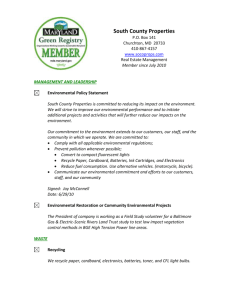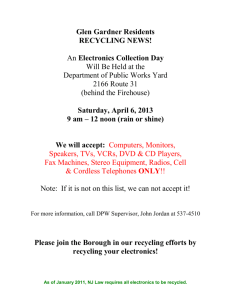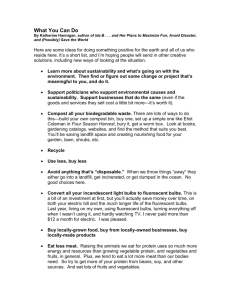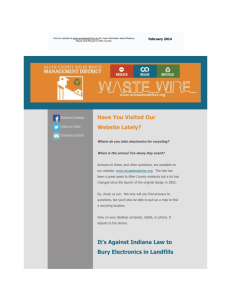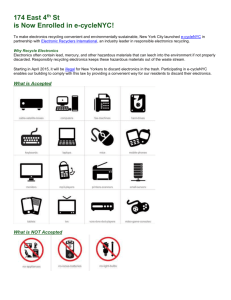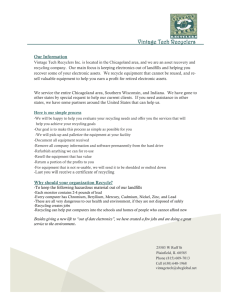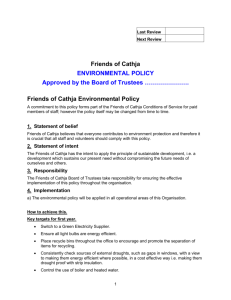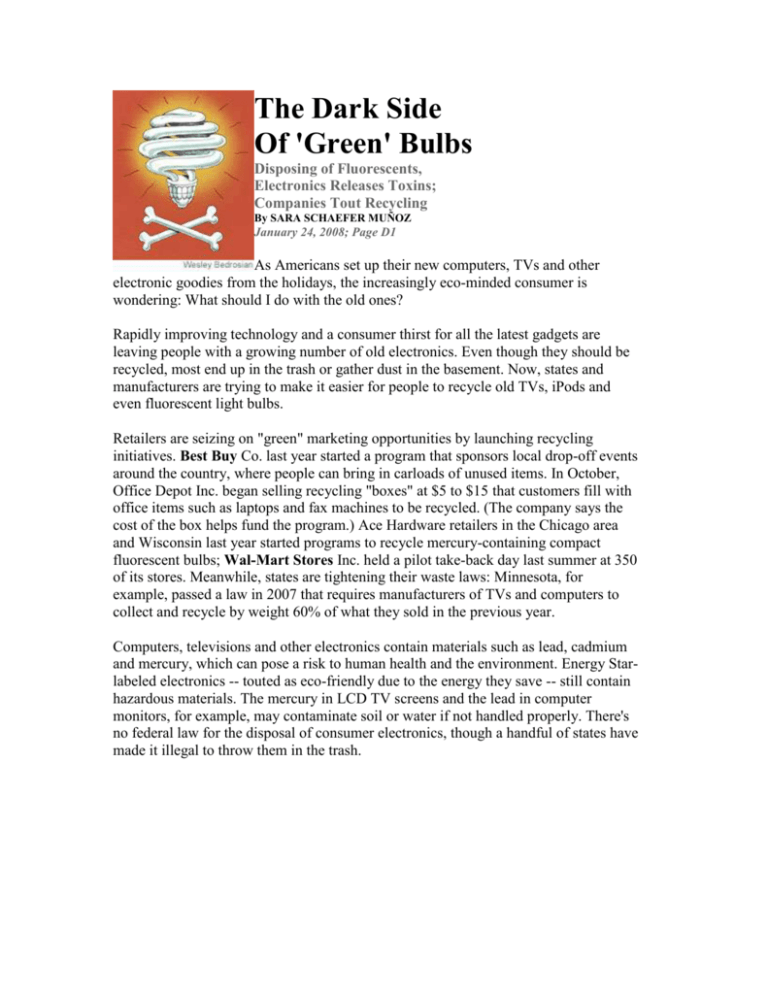
The Dark Side
Of 'Green' Bulbs
Disposing of Fluorescents,
Electronics Releases Toxins;
Companies Tout Recycling
By SARA SCHAEFER MUÑOZ
January 24, 2008; Page D1
As Americans set up their new computers, TVs and other
electronic goodies from the holidays, the increasingly eco-minded consumer is
wondering: What should I do with the old ones?
Rapidly improving technology and a consumer thirst for all the latest gadgets are
leaving people with a growing number of old electronics. Even though they should be
recycled, most end up in the trash or gather dust in the basement. Now, states and
manufacturers are trying to make it easier for people to recycle old TVs, iPods and
even fluorescent light bulbs.
Retailers are seizing on "green" marketing opportunities by launching recycling
initiatives. Best Buy Co. last year started a program that sponsors local drop-off events
around the country, where people can bring in carloads of unused items. In October,
Office Depot Inc. began selling recycling "boxes" at $5 to $15 that customers fill with
office items such as laptops and fax machines to be recycled. (The company says the
cost of the box helps fund the program.) Ace Hardware retailers in the Chicago area
and Wisconsin last year started programs to recycle mercury-containing compact
fluorescent bulbs; Wal-Mart Stores Inc. held a pilot take-back day last summer at 350
of its stores. Meanwhile, states are tightening their waste laws: Minnesota, for
example, passed a law in 2007 that requires manufacturers of TVs and computers to
collect and recycle by weight 60% of what they sold in the previous year.
Computers, televisions and other electronics contain materials such as lead, cadmium
and mercury, which can pose a risk to human health and the environment. Energy Starlabeled electronics -- touted as eco-friendly due to the energy they save -- still contain
hazardous materials. The mercury in LCD TV screens and the lead in computer
monitors, for example, may contaminate soil or water if not handled properly. There's
no federal law for the disposal of consumer electronics, though a handful of states have
made it illegal to throw them in the trash.
More People Recycling
According to the Environmental Protection Agency, old consumer electronics
accounted for about 1.5% of 250 million tons of trash in 2006, up from 1% in 2000.
According to a 2006 report from the International Association of Electronics
Recyclers, an industry group based in Albany, N.Y., roughly 15% to 20% of electronic
waste was recycled, up from 10% to 15% in 2003. The figures don't include products
that were returned to manufacturers for recycling.
Some environmental advocates and researchers warn that many recycled items may
end up in landfills anyway, or be recycled improperly in poorer countries.
Nevertheless, more people are interested in recycling. Richard Leventhal, a smallbusiness owner in Wellington, Fla., admits that he has put cellphones, a TV and a
computer monitor in the garbage in the past. "I really didn't put a whole lot of thought
into it," he says. "But with this attention to the environment, I started to."
He was in Office Depot about two months ago and saw a pamphlet for the officesupply chain's recycling program. He now takes his personal and business electronics
in, because "it's easy. I just fill a box and bring it back."
Another product that should be recycled is the fluorescent light bulb. As part of the
government's focus on energy and the environment, Americans are urged to buy
compact fluorescent light bulbs, which use only about 25% of the energy and last up to
10 times as long as traditional incandescent bulbs. Nearly 300 million such bulbs were
sold in U.S. in 2007, compared with 100 million two years earlier, according to the
Department of Energy.
Avoiding the Landfill
Yet unlike traditional incandescent bulbs, these bulbs contain mercury, a metal
hazardous to human health and the environment. Consumers are urged not to toss them
in the trash. In some states, such as California, it's illegal to throw them away; they
must be recycled. Still, many cities and towns don't have recycling programs for the
bulbs, and consumers aren't sure what to do with them.
"Who's going to read the warnings on a lightbulb package?" asks John Roth, a sales
manager in Portland, Ore. He has several bulbs around his house. He plans to call his
local recycling program to figure out what to do when they burn out after their average
lifespan of five to seven years.
An estimated 25% of all mercury-containing bulbs -- including residential compact
fluorescents -- are recycled, according to Paul Abernathy, the executive director of the
Association of Lighting and Mercury Recyclers, an industry group in Calistoga, Calif.
There are little more than two dozen licensed facilities in the U.S. for processing
mercury waste, he says.
"Everywhere we go,
we are being
encouraged to use
[compact fluorescent
bulbs], but there's
really a lack of
reasonably accessible
drop-off spots" when
they burn out, he says.
Mercury Hazard
The amount of mercury
in compact fluorescent
bulbs is small, about
five milligrams at the
most, and is sealed
inside the glass tubing, according to the EPA. Manufacturers have been working to
lower that amount. As long as people clean up broken bulbs right away and don't let
kids touch them, people should be able to prevent contamination in their home, says
Ellen Silbergeld, a professor of environmental health sciences at Johns Hopkins
University. (The government suggests airing out the room for at least 15 minutes as a
precaution.) Yet Ms. Silbergeld says she is more concerned about the environmental
impact if millions of these bulbs end up in landfills or incinerators.
"I don't think anybody has really grappled with this," she says.
The Department of Energy, which encourages consumers to purchase the energysaving bulbs, acknowledges they can be "cumbersome to recycle and dispose of," but
says the agency is working to increase the availability of options. The agency also says
that coal-fired power plants are the greatest source of environmental mercury -- U.S.
power plants emitted 50 tons of mercury in 2006 -- and using compact fluorescent
bulbs cuts down on the amount of coal burned to make electricity.
When it comes to computers, many major manufacturers -- such as Apple Inc. and
Dell Inc. -- will take old computers back. The recycling of TVs, especially large ones,
is also onerous. Sony Electronics started a take-back program in September. Until midMarch the company will offer consumers a $100 credit toward a new Sony TV if they
bring in an old one. Consumers can find a list of more than 80 drop-off points at
www.sony.com/recycle.
If consumers want to know what else to do with their old electronics or fluorescent
bulbs, several Web sites can help them find a drop-off place in their area, such as
www.earth911. org and www.epa.gov/bulbrecycling. They can also check with the
manufacturer, as well as their local utility and waste-management division.
Yet there is some concern about where the "recycled" items actually end up.
According to Barbara Kyle, the national coordinator for the Electronics TakeBack
Coalition, a national group based in San Francisco that promotes responsible recycling,
roughly 50% to 80% of electronic waste that goes to recyclers goes on to developing
countries, especially China, where it often isn't properly dealt with. There, workers
break apart the items to get at the metals and other components that can be resold and
are often exposed to toxic substances in the process. (The International Association of
Electronics Recyclers says that there are good and bad recycling operations all over the
world and that it urges its members to adhere to best industry practices.)
Ms. Kyle suggests that, if possible, consumers recycle their items through the
manufacturer because the manufacturer is likely to have responsible practices to
protect its reputation. Consumers can also check a database called e-Stewards at
www.ban.org. There, they can search for a local recycling firms that have taken a
pledge not to export the waste to developing countries or allow it to end up in landfills
or incinerators.
Write to Sara Schaefer Muñoz at sara.schaefer@wsj.com1
URL for this article:
http://online.wsj.com/article/SB120114002163112121.html
Hyperlinks in this Article:
(1) mailto:sara.schaefer@wsj.com
Copyright 2008 Dow Jones & Company, Inc. All Rights Reserved
This copy is for your personal, non-commercial use only. Distribution and use of this
material are governed by our Subscriber Agreement and by copyright law. For non-personal
use or to order multiple copies, please contact Dow Jones Reprints at 1-800-843-0008 or
visit www.djreprints.com.
RELATED ARTICLES AND BLOGS
Related Content may require a subscription | Subscribe Now -- Get 2 Weeks FREE
Related Articles from the Online Journal
• Bye Bye, Light Bulb
• Consumer Bankruptcy Filings Rose 40% in '07
• If Recession Comes, It Likely Will Hit Hard
Blog Posts About This Topic
• Government Pushing Fluorescent Bulbs with Hazardous Mercury
More related content Powered by Sphere
artdiamondblog.com


